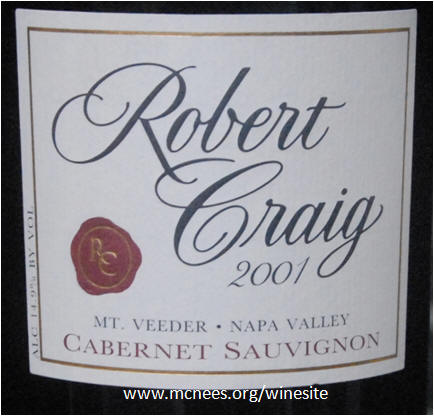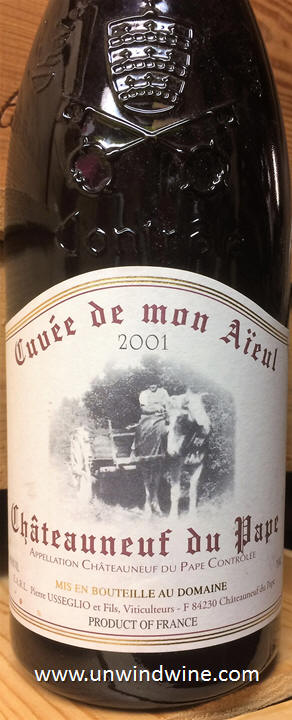Family dinner features broad diverse wine flight - Robert Craig, Del Dotto, Pirouette, Domaine Pegau and Hill Estate
I wrote in the previous post about sister
Jan and Bro-n-law Bill visiting from California with daughters Jenna and Krysta and her new
grand-baby to meet the cousins, the family gathered at our house for a
family reunion dinner. Linda prepared beef tenderloin and ribs with
asparagus, whipped potatoes and mac-n-cheese, salads and desserts.
We opened a broad diverse wine flight to accompany the dinner courses and selections.
For the beef tenderloin, we opened a series of reds including this family oriented and run Napa Cabernet from Del Dotto Vineyards, followed by Robert Craig, two of the largest selections in our cellar collection spanning three decades.
We also opened a Long
Shadows Pirouette Red Blend, from their Vintner's Collection, another producer label of which we own a
broad collection spanning many vintages going back more than a decade.
For the ribs' accompaniment, son Ryan brought a CDP and son Alec brought a Napa Syrah to
round out the flight.
A separate post covered the white wine offering I opened - Long Shadows Poet's Leap Riesling.
My blogpost features our last visit there during our Napa Valley Del Dotto Estate Cave Tour and Barrel Tasting in 2017.
Tonight, I opened a large format magnum bottle of Del
Dotto Napa Valley Cabernet Sauvignon from the 2000 vintage, an Estate and a
bottle from their Connoisseur's Series.
Del Dotto produce this unique series
featuring a wine aged in different oak barrels with different types of
oak sourced from around the world. The premise is that different
varieties of oak have specific characteristics that will act upon the
wine differently resulting in subtle flavor variations.
The Del Dotto Connoisseur's Series features as many as nine
different oaks in which they age the same wine. Oaks barrels are
produced with wood sourced from numerous forests around the world
including America and France - French Allier, Bertranges, Colbert,
this one from Juppilles, Marsannay and Troncas oaks, and
American Missouri and Minnesota oaks. As with the whole collection, the
resulting differences are subtle and may not be discernible except to
the most discriminating oenophile, but they provide a unique and
interesting tasting experience.
 |
| Del Dotto Connoisseur Series Cabernet Sauvignon served at an earlier wine tasting |
Still holding its own at two decades plus two years, this is certainly reached its prime and will not improve further with aging but was not showing any diminution from age, perhaps due to large format bottle, which tends to age better.
Dark garnet purple colored, medium to full bodied, modest structure, black berry fruits, notes of cassis, black tea, leather and hints of creosote on a moderate finish.
RM 88 points.
https://www.cellartracker.com/wine.asp?iWine=530962
https://www.deldottovineyards.com/
@DelDottoWine
Robert Craig Mt Veeder Napa Valley Cabernet Sauvignon 2001
We're long time fans of Robert and Marilyn and the Craig team and their 'artwork'. Our friendship with Robert and our 'Affinity' for his wines dates back at our first visit to Robert Craig during our Napa Valley Wine Experience in 1996, and then again at our Robert Craig featured producer wine dinners during our Napa Wine Experience 1998, and again in 1999.
https://unwindwine.blogspot.com/2017/12/robert-craig-veeder-cinq-cepages-byob.html
https://mcnees.org/winesite/napa/napa_08/img_napa08_robt_craig_friends_lunch_remc.jpg
@RobertCraigWine
We also opened another Long Shadows Vintners Collection label, Pirouette, a red blend crafted by legendary producer/winemakers Phillip Melka and Agustin Huneeus, Sr.
Long Shadows Pirouette Red Wine 2004
This is the Bordeaux varietal red blend from the Long Shadows Vintners's Collection that features world class winemakers and Washington State Columbia Valley fruit.
Two legendary winemakers, Philippe Melka and Agustin Huneeus, Sr. teamed to combine the heritage of old world winemaking with the advancements of new world technology, using small lots from Washington State’s finest vineyards to craft this exotic red blend.
Agustin Huneeus entered the wine business in Chile in 1960 to lead Concha y Toro, a company he grew to become Chile’s largest winery. In 1971, he moved to New York, then later to California, continuing in the wine industry before becoming a partner and president of Franciscan Estates in 1985.
In addition to building Franciscan, he also built well-known California wineries Estancia and Mount Veeder and Veramonte Winery in Chile. In 1999, he left Franciscan to establish Huneeus Vintners, a portfolio that includes Napa Valley’s Quintessa where he worked with talented winemaker Phillip Melka.
Philippe Melka attended the University of Bordeaux earning a master's degree in agronomy and enology, before working at some of the most famous wineries in the world: Château Cheval Blanc, Pétrus and Château Haut-Brion, among others. There he developed a passion for and expertise in cabernet-based blends.
In 1994, Philippe settled in Napa Valley where he developed his reputation making wines for such celebrated wineries as Hundred Acre, Quintessa, Bryant Family, Seavey, Dana Estates and Vineyard 29 before joining the dream project partnering with Agustin Hunneus from Quintessa and Allen Shoup at Long Shadows.
The Pirouette Vintners' Collection label collaboration was launched with the inaugural 2003 vintage. This, the second release in 2004 was a unique red blend consisting of 49% Cabernet Sauvignon, 27% Merlot, 13% Petit Verdot and 11% Syrah.
Seeking to create a wine with complexity and layers, the winemakers chose a diverse
selection of Columbia Valley vineyard sites, each contributing unique
characteristics to the blend. Grapes from the Horse Heaven Hills vineyards
(32%) contributed depth; Wahluke Slope (24%) provided richness,
concentration and dark fruit; Columbia Valley (25%) added ripe fruit
character; the Yakima Valley (5%) gave the wine its balance and acidity;
and Petit Verdot from Ciel du Cheval on Red Mountain (14%) further
enhanced balance and complexity.
The wine was aged 21months in 100% all French oak (75% new) barrels.
This release was awarded 93 points by Wine Advocate.The expressive nose offers up pain grille, scorched earth, blueberry, and blackberry liqueur. This is followed by a thick wine with silky tannins, superb depth and richness, and layers of flavor.
This was consistent with earlier tasting, CT records show we last opened this label and tasted it over the holidays in December 2018 when I wrote: "I like this wine: While it is a blend of Bordeaux varietals Cabernet, Merlot, and Petit
Verdot, it also contains a percentage of Syrah. It seems the Syrah
almost predominated with a residual sweetness un-befitting the blend.
The blend is 49% Cabernet, 37% Merlot, 13% Petit Verdot and 11% Syrah.
It is showing no signs of diminution from aging at fourteen (now eighteen) years and
seems to still be at the apex of its drinking window.'
"The cork
came apart on opening so the server had to decant this and strain it to
remove the crumbled cork and residual sediment. Bright ruby colored,
medium-full bodied, vibrant, rich concentrated forward black and blue
fruits with highlights of black cherry, notes of cassis, spice and hints
of cedar and creosote giving way to sweet almost obtuse bing cherry
notes on the tangy lingering finish."
RM 90 points.
@LongShadowsWine
For pairing with the baby back ribs, we opened two bottles brought by Ryan and Alec respectively.
Domaine du Pegau "Cuvée Reservée" Châteauneuf-du-Pape 2003
http://unwindwine.blogspot.com/2015/05/pichon-baron-and-viader-v-1999-flight.html
This blockbuster vintage release got 99 points from Jeb Dunnuck. 98 points from Robert Parker's Wine Advocate and 97 points from Wine Spectator.
Robert Parker wrote about this release in Wine Advocate back in 2010: "The 2003 Chateauneuf du Pape Cuvee Reservee stands out as one of the all-time great wines made by Laurence Feraud and her father, Paul." Later in 2014 he wrote, "Starting with the 2003 Châteauneuf du Pape Cuvée Reservée, this wine showed spectacularly on release, closed down for a few years, and has now emerged, at close to full maturity, and is straight-up fabulous."
Parker's tasting notes at that time referred to 'currants, garrigue, pepper and beef blood'.
Wine Spectator in 2006 cited this "Highly Recommended, #5 in Top 100 Wines of 2006" and described it with notes of "bramble, licorice, tar and pain d'épices flavors before a flitter of game and garrigue on the finish."
Its a tough comparison, this old world style
compared to the modern era style and more robust, vibrant and expressive
fruits from Bordeaux varietals. A wonderful tasting when compared with the BBQ ribs
in any event.
https://www.cellartracker.com/wine.asp?iWine=19857
Hill Family Estate Napa Valley Clarke Vineyard Syrah 2018
Alec brought this hearty Syrah to pair with the ribs. We've written often in these pages about his discovering this producer and their portfolio during his and Vivianna's Napa Valley honeymoon that was disrupted by the raging fires. They acquired this label as part of their wine club allocation shipment.https://unwindwine.blogspot.com/2020/12/hill-family-estate-origin-napa-valley.html
https://unwindwine.blogspot.com/2022/03/hill-family-estate-napa-cabernet-2018.html
Winemaker's notes about this wine: "The Clarke Vineyard in American Canyon has a cool breezy climate that brings out the depth and finesse of the Syrah grape. Clone 877 is used for body and raspberry chocolate fruit, and a little Clone 383 for extra color and smoky complexity. A small amount of Viognier was co-fermented with the Syrah to add its exotic appeal. We brought the grapes in on October 23 at 27 Brix. We gave the tank 3 days of cold soak before adding FX10 yeast, then pressed it on November 4. The 2018 Clarke Syrah offers intriguing aromas of dark plum, black cherry, iris flower and wafts of mezcal. The wine glides across the tongue with flavors of raspberry and melted milk chocolate."
Dark purple colored, full bodied, notes of blackberry and black raspberry fruits accented by dark mocha chocolate hints of smoke and black tea.
RM 91 points.
https://www.cellartracker.com/wine.asp?iWine=3975107
https://store.hillfamilyestate.com/product/2018-Clarke-Vineyard-Syrah







































